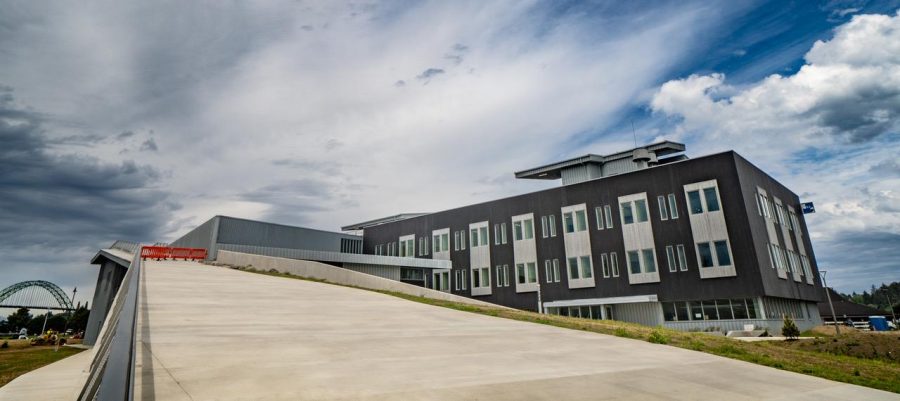OSU develops new housing in Newport, plans to open Marine Studies Building this month
July 14, 2020
Oregon State University will move forward with its new housing development in Newport, Ore., and plans to open a new Marine Studies building at the Hatfield Marine Science Center this month.
The new housing development and Marine Studies building will help fulfill OSU’s Marine Studies Initiative, which strives to “create a healthy future for our ocean and the planet through transdisciplinary research and teaching that emphasizes collaboration, experiential learning, engagement with society and problem solving,” according to the OSU Marine Studies website.
Mark Farley, the strategic initiatives manager for the Hatfield Marine Science Center, noted that current housing in Newport is an outdated collection of apartments and bunkhouses, and is unable to accommodate growth at the coast.
“It went in in the 70’s, so not very current. It’s a little summer campy, and at max capacity—and I mean max capacity. We’re breathing down each other’s necks, and it holds about 100 students,” Farley said. “That actually has been the limiting factor around any academic growth at Hatfield.”
Farley said the new housing development will add about 160 beds, and is built to flex, based on need and length of residency.
“If you’re a year-round student, you would be in a situation where you’re not as dense. If you’re there for a weekend course, you’re going to be dense,” Farley said.
The new housing will not be a dorm building, like those seen on the OSU Corvallis campus. Rather, they will be smaller duplex-sized units, with shared kitchen and living spaces, according to Jack Barth, the executive director of the OSU Marine Studies Initiative and a professor in the College of Earth, Ocean and Atmospheric Sciences.
The housing development will also be built out of the tsunami zone, near Oregon Coast Community College, approximately a 10-15 minute walk from the Hatfield campus.
“The most important thing is that President Ray and all of us are committed to the safety of the students at the coast. So, the pledge is to build the housing up on the hill towards the community college, above the inundation zone,” Barth said.
While the new housing development is in the works, the Marine Studies Building is nearly complete. The new building is approximately 72,000 square feet, and houses laboratories for research, classrooms, offices and an auditorium.
“Hatfield has been full for 15 years. All of our labs are full, all of our offices are double bunked, we’re full,” Farley said. “So new lab space means we have room for new science to come in, new lab spaces that are built in really modern and progressive ways means we change some of how everybody works together. We can support more collaborative teams, we can share equipment easier.”
Bob Cowen, director of the Hatfield Marine Science Center, said there can be up to 400-450 people on the Hatfield campus, depending on the time of year. About 200 of those individuals include state or federal employees—such as the National Oceanic and Atmospheric Administration, the United States Department of Agriculture, the Environmental Protection Agency and Oregon Department of Fish and Wildlife—and about 200-250 people are from OSU.
Farley said many students benefit from internship opportunities with the agencies who work in collaboration with OSU scientists.
“It’s kind of one big scientific community with different acronyms attached to different endeavors,” Farley said.
The goal is to complete the new housing development by summer 2021—and, depending on COVID-19 delays, the new Marine Science Building will likely open this month, according to Farley.
Barth said new housing will allow students to see the ocean and its ecosystem over longer periods of time, and make observation and experiences more accessible to OSU students.
“The way you really learn about the ocean and coast is to be onsite for a while. A very obvious one is you have to stay 12 hours to see the tide go up and down once, and then a storm system can last a couple of days. If you’ve ever been out to the coast and watched those start up and go away—that’s another amazing experience,” Barth said. “Just that sense of time that we want to have students stay out there, and the housing lets us do that.”
Cowen said one of his long-term goals as director is to see a growth in the disciplinary activity at Hatfield, and to have more colleges represented at the coast.
Likewise, Farley said the new buildings and growth at Hatfield helps fulfill OSU’s Marine Studies Initiative, since it encourages a wide variety of students, staff and faculty to spend time at the coast.
“We’re in an era where shifting ecosystems is kind of the number one question for a lot of oceanographers and biologists. Interdisciplinary teams are what is nationally competitive, and we’re solving more than just scientific problems—we are also solving social problems,” Farley said. “So, the people of the coast live here—we need to build resilient, adaptive communities. We do that with interdisciplinary teams. It’s not just answering one question, it’s looking at answers that are part of a complex system.”
Barth said the housing development plans have been approved by the OSU Board of Trustees, but there is one additional approval step that will take place in the summer with the Board before building can start.
“I think we need to be honest that we’re going to face a decision with the COVID challenge about investing resources [at the coast]. And the way I explain it is good ideas don’t go away just because there are challenges,” Barth said. “We’ve all agreed, across the whole university, that Marine Studies is one of our strengths, and we’re going to build it out. So we may face a pause, or a delay, but we’re still going to go ahead.”
More information on OSU’s Marine Studies Initiative can be found at the OSU Marine Studies website.















































































































